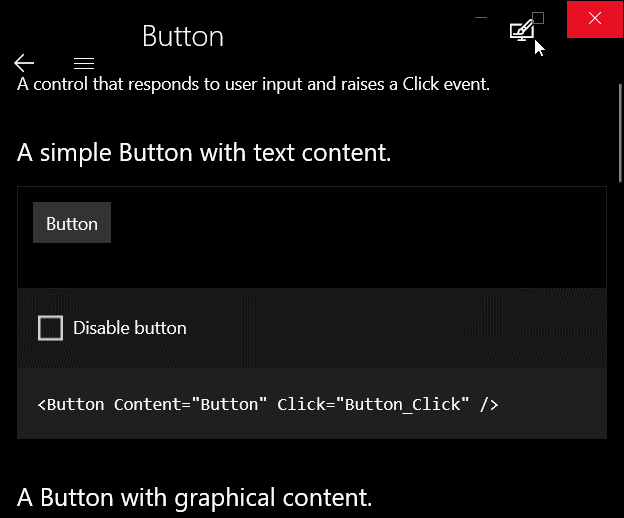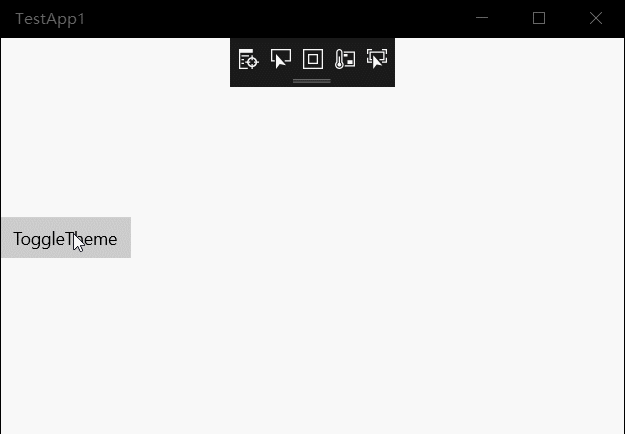前些日子看到Xaml Controls Gallery的ToggleTheme过渡非常心水,大概是这样的:
在17134 SDK里写法如下:
<Grid Background="{ThemeResource ApplicationPageBackgroundThemeBrush}">
<Grid.BackgroundTransition>
<BrushTransition Duration="0:0:0.4" />
</Grid.BackgroundTransition>
</Grid>这和我原本的思路完全不同。
我原本的思路是定义一个静态的笔刷资源,然后动画修改他的Color,但是这样就不能和系统的笔刷资源很好的融合了。怎么办呢?
前天半梦半醒间,突然灵光一现,感觉可以用一个附加属性作为中间层,给Background赋临时的笔刷实现过渡。
闲话不多说,开干。
首先我们需要一个画刷,这个画刷要实现以下功能:
- 拥有一个Color属性。
- 对Color属性赋值时会播放动画。
- 动画播放结束触发事件。
- 可以从外部清理事件。
这个可以使用Storyboard,CompositionAnimation手动Start或者ImplicitAnimation实现,在这里我选择了我最顺手的Composition实现。
下面贴代码:
public class FluentSolidColorBrush : XamlCompositionBrushBase
{
Compositor Compositor => Window.Current.Compositor;
ColorKeyFrameAnimation ColorAnimation;
bool IsConnected;
//被设置到控件属性时触发,例RootGrid.Background=new FluentSolidColorBrush();
protected override void OnConnected()
{
if (CompositionBrush == null)
{
IsConnected = true;
ColorAnimation = Compositor.CreateColorKeyFrameAnimation();
//进度为0的关键帧,表达式为起始颜色。
ColorAnimation.InsertExpressionKeyFrame(0f, "this.StartingValue");
//进度为0的关键帧,表达式为参数名为Color的参数。
ColorAnimation.InsertExpressionKeyFrame(1f, "Color");
//创建颜色笔刷
CompositionBrush = Compositor.CreateColorBrush(Color);
}
}
//从属性中移除时触发,例RootGrid.Background=null;
protected override void OnDisconnected()
{
if (CompositionBrush != null)
{
IsConnected = false;
ColorAnimation.Dispose();
ColorAnimation = null;
CompositionBrush.Dispose();
CompositionBrush = null;
//清除已注册的事件。
ColorChanged = null;
}
}
public TimeSpan Duration
{
get { return (TimeSpan)GetValue(DurationProperty); }
set { SetValue(DurationProperty, value); }
}
public static readonly DependencyProperty DurationProperty =
DependencyProperty.Register("Duration", typeof(TimeSpan), typeof(FluentSolidColorBrush), new PropertyMetadata(TimeSpan.FromSeconds(0.4d), (s, a) =>
{
if (a.NewValue != a.OldValue)
{
if (s is FluentSolidColorBrush sender)
{
if (sender.ColorAnimation != null)
{
sender.ColorAnimation.Duration = (TimeSpan)a.NewValue;
}
}
}
}));
public Color Color
{
get { return (Color)GetValue(ColorProperty); }
set { SetValue(ColorProperty, value); }
}
public static readonly DependencyProperty ColorProperty =
DependencyProperty.Register("Color", typeof(Color), typeof(FluentSolidColorBrush), new PropertyMetadata(default(Color), (s, a) =>
{
if (a.NewValue != a.OldValue)
{
if (s is FluentSolidColorBrush sender)
{
if (sender.IsConnected)
{
//给ColorAnimation,进度为1的帧的参数Color赋值
sender.ColorAnimation.SetColorParameter("Color", (Color)a.NewValue);
//创建一个动画批,CompositionAnimation使用批控制动画完成。
var batch = sender.Compositor.CreateScopedBatch(CompositionBatchTypes.Animation);
//批内所有动画完成事件,完成时如果画刷没有Disconnected,则触发ColorChanged
batch.Completed += (s1, a1) =>
{
if (sender.IsConnected)
{
sender.OnColorChanged((Color)a.OldValue, (Color)a.NewValue);
}
};
sender.CompositionBrush.StartAnimation("Color", sender.ColorAnimation);
batch.End();
}
}
}
}));
public event ColorChangedEventHandler ColorChanged;
private void OnColorChanged(Color oldColor, Color newColor)
{
ColorChanged?.Invoke(this, new ColorChangedEventArgs()
{
OldColor = oldColor,
NewColor = newColor
});
}
}
public delegate void ColorChangedEventHandler(object sender, ColorChangedEventArgs args);
public class ColorChangedEventArgs : EventArgs
{
public Color OldColor { get; internal set; }
public Color NewColor { get; internal set; }
}
这样这个笔刷在每次修改Color的时候就能自动触发动画了,这完成了我思路的第一步,接下来我们需要一个Background属性设置时的中间层,用来给两个颜色之间添加过渡,这个使用附加属性和Behavior都可以实现。
我开始选择了Behavior,优点是可以在VisualState的Storyboard节点中赋值,而且由于每个Behavior都是独立的属性,可以存储更多的非公共属性、状态等;但是缺点也非常明显,使用Behavior要引入"Microsoft.Xaml.Behaviors.Uwp.Managed"这个包,使用的时候也要使用至少三行代码。
而附加属性呢,优点是原生和短,缺点是不能存储过多状态,也不能在Storyboard里使用,只能用Setter控制。
不过对于我们的需求呢,只需要Background和Duration两个属性,综上所述,最终我选择了附加属性实现。
闲话不多说,继续贴代码:
public class TransitionsHelper : DependencyObject
{
public static Brush GetBackground(FrameworkElement obj)
{
return (Brush)obj.GetValue(BackgroundProperty);
}
public static void SetBackground(FrameworkElement obj, Brush value)
{
obj.SetValue(BackgroundProperty, value);
}
public static TimeSpan GetDuration(FrameworkElement obj)
{
return (TimeSpan)obj.GetValue(DurationProperty);
}
public static void SetDuration(FrameworkElement obj, TimeSpan value)
{
obj.SetValue(DurationProperty, value);
}
public static readonly DependencyProperty BackgroundProperty =
DependencyProperty.RegisterAttached("Background", typeof(Brush), typeof(TransitionsHelper), new PropertyMetadata(null, BackgroundPropertyChanged));
public static readonly DependencyProperty DurationProperty =
DependencyProperty.RegisterAttached("Duration", typeof(TimeSpan), typeof(TransitionsHelper), new PropertyMetadata(TimeSpan.FromSeconds(0.6d)));
private static void BackgroundPropertyChanged(DependencyObject d, DependencyPropertyChangedEventArgs e)
{
if (e.NewValue != e.OldValue)
{
if (d is FrameworkElement sender)
{
//拿到New和Old的Brush,因为Brush可能不是SolidColorBrush,这里不能使用强制类型转换。
var NewBrush = e.NewValue as SolidColorBrush;
var OldBrush = e.OldValue as SolidColorBrush;
//下面分别获取不同控件的Background依赖属性。
DependencyProperty BackgroundProperty = null;
if (sender is Panel)
{
BackgroundProperty = Panel.BackgroundProperty;
}
else if (sender is Control)
{
BackgroundProperty = Control.BackgroundProperty;
}
else if (sender is Shape)
{
BackgroundProperty = Shape.FillProperty;
}
if (BackgroundProperty == null) return;
//如果当前笔刷是FluentSolidColorBrush,就将当前笔刷设置成旧笔刷,触发FluentSolidColorBrush的OnDisconnected,
//OnDisconnected中会清理掉ColorChanged上注册的事件,防止笔刷在卸载之后,动画完成时触发事件,导致运行不正常。
if (sender.GetValue(BackgroundProperty) is FluentSolidColorBrush tmp_fluent)
{
sender.SetValue(BackgroundProperty, OldBrush);
}
//如果OldBrush或者NewBrush中有一个为空,就不播放动画,直接赋值
if (OldBrush == null || NewBrush == null)
{
sender.SetValue(BackgroundProperty, NewBrush);
return;
}
var FluentBrush = new FluentSolidColorBrush()
{
Duration = GetDuration(sender),
Color = OldBrush.Color,
};
FluentBrush.ColorChanged += (s, a) =>
{
sender.SetValue(BackgroundProperty, NewBrush);
};
sender.SetValue(BackgroundProperty, FluentBrush);
FluentBrush.Color = NewBrush.Color;
}
}
}
}
调用的时候就不能直接设置Background了:
<Grid helper:TransitionsHelper.Background="{ThemeResource ApplicationPageBackgroundThemeBrush}">
<Button x:Name="ToggleTheme" Click="ToggleTheme_Click">ToggleTheme</Button>
</Grid>在Style里调用方法也类似
<!-- Element中 -->
<Grid x:Name="RootGrid" helper:TransitionsHelper.Background="{TemplateBinding Background}">
...
</Grid>
<!-- VisualState中 -->
<VisualState x:Name="TestState">
<VisualState.Setter>
<Setter Target="RootGrid.(helper:TransitionsHelper.Background)" Value="{Binding RelativeSource={RelativeSource TemplatedParent},Path=SecondBackground}" />
</VisualState.Setter>
</VisualState>这里还有个点要注意,在VisualState中,不管是Storyboard还是Setter,如果要修改模板绑定,直接写Value="{TemplateBinding XXX}"会报错,正确的写法是Value="{Binding RelativeSource={RelativeSource TemplatedParent},Path=SecondBackground}"。
最后附一张效果图: